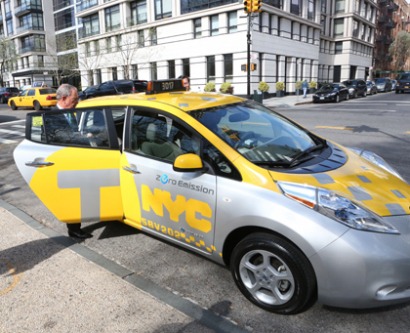
They were joined by Ken Srebnik, Head of Corporate Planning for Environmental Initiatives at Nissan North America.
The Nissan-donated vehicles will join the city’s fleet of 13,237 iconic medallion taxicabs to see how their charging dynamic will fit into the typical 24/7 day-to-day business model of the taxi industry, and help the NYC Taxi and Limousine Commission (TLC) to determine how best to lay the foundation for a one-third electric taxi fleet by the year 2020.
“Even though the Taxi of Tomorrow won’t be on the road for another six months, we’re already looking ahead to the taxi of the day after tomorrow,” said Mayor Bloomberg. “Nissan’s proven track record with electric vehicles will put us ahead of the curve in helping us answer important questions about incorporating electric taxis into the fleet so that we can achieve the goal of a one-third electric taxi fleet by 2020.”
Aside from the environmental benefit of electric taxicabs (an allelectric NYC taxi fleet would potentially reduce CO2 emissions by nearly 90,000 tons annually), taxi operators would see significantly reduced fuel and maintenance costs. the city said.
Calculated at current gas prices, fueling a taxicab costs up to $17,500 a year, while powering taxis with electricity would be considerably less expensive. With no belts to wear out, and no combustion engine to require oil changes, routine maintenance costs would also be greatly reduced.
To these combined ends, the Bloomberg Administration has convened a taskforce to electrify one-third of the city’s taxi fleet by 2020, a goal announced by Mayor Bloomberg during his February 14 State of the City address.
Partners on the Nissan LEAF project include the Mayor’s Office of Long-Term Planning and Sustainability, the NYC Department of Transportation, US Department of Energy, AeroVironment, Related Management, Seward Park Cooperative, Con Edison, New York State Energy Research and Development Authority, and the New York Power Authority.
“Our next steps on the road to a more environmentally-responsible and fuel-efficient future for the taxi industry are crucial ones,” said Taxi and Limousine Commissioner David Yassky. “These all-electric LEAF taxicabs will help us determine the best way to seamlessly integrate electric vehicles into the taxi industry’s 24/7 business and operational models.”
Joe Castelli, vice president, Nissan Commercial Vehicles said: “As part of our commitment to zero emission vehicles for the mass-market, Nissan is looking for ways to broaden the use of electric cars, including commercial applications like taxis."
"Our relationship with the city provides us the ultimate proving ground to conduct this LEAF taxi pilot to help optimize the use of electric vehicle technology for future applications,” Castelli said.
Sergej Mahnovski, Director of the Mayor’s Office of Long-term Planning and Sustainability, said “Because taxis drive over 60,000 miles per year, meeting the mayor’s goal of 1/3 fleet electrification is the equivalent of taking 50,000 regulars cars off the road. Through TLC’s leadership we are seeing if electric cars can make it in one of the toughest applications there is. This and other PlaNYC initiatives help New York City meet its goals of having the cleanest air quality of any major U.S. City and reducing its climate change emissions 30 percent by 2030.
Owner/operators, fleet agents and lease drivers, will experience the Nissan LEAFs in single-shift increments. The vehicles will be charged at owners’ homes or fleet garages using standard chargers and at several locations with the city’s first fast chargers.
Using a fast charger, a Nissan LEAF battery can go from empty to an 80 percent charge in approximately 30 minutes, which will be important for single-shift taxi drivers for whom every minute counts, the city said.
For additional information:

